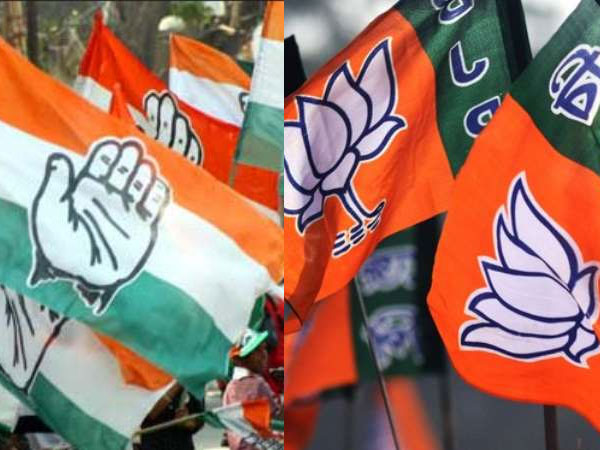Despite BJP’s strong presence in the Hindi belt states, it is unlikely that it will sweep all the states.
With the dates of the elections for the formation of the 18th Lok Sabha approaching, speculation has begun in both Congress and BJP about the results. While Prime Minister Narendra Modi and the entire NDA look confident of the slogan “is baar 400 paar”, meaning crossing 400 this time, the Congress is expecting a miracle this time like in 2004. It means that somehow Congress is expecting 140 to 150 seats.
Congress is grappling with uncertainty regarding its seat allocation, lacking a clear strategy for securing seats even in Hindi belt states. Conversely, the BJP anticipates a ceiling of 250 seats, with political discourse suggesting a waning of the BJP wave. However, the veracity of these projections will be revealed on 4 June.
Despite speculation of a diminishing Modi wave, the prevailing atmosphere suggests otherwise. The BJP’s campaign leading up to the elections has been heavily steeped in Hindutva, evident from the consecration of Ram Lala’s idol in Ayodhya’s Ram temple on 22 January. This event served as a precursor to BJP’s electoral narrative, anchoring its campaign around the Ram temple issue. Thus, it is evident that the BJP is positioning itself to contest the 2024 elections on a platform centered on Hindutva.
The voting process for the formation of the 18th Lok Sabha will begin from 19 April. The final phase of voting will be held on 1 June. The results will be declared on 4 June.
Talking about the strategy, Prime Minister Modi is seeking votes on the basis of his work and decisions by making his decisions an issue, but while mentioning Ayodhya, he speaks strongly on Sanatan Dharma. Besides, patriotism is another important issue which seems to be enough to change the mood of the voters, because the Opposition is not able to speak on these issues. As far as work is concerned, electricity, water, railway expansion, roads, financial help to farmers, free food to 90 crore people are the important issues of the Prime Minister. In terms of decisions, Article 370 was abolished in Kashmir, the building of the Ram temple in Ayodhya, abolition of triple talaq, 33% reservation for women in the Lok Sabha and Assembly in the future, etc. It is during these issues that the Opposition is attacked regarding the Ram temple. There is no doubt that Ayodhya and Ram Temple were and are being discussed in the entire country. Even in states like Tamil Nadu and Kerala, BJP is hoping to win seats this time on the basis of Ayodhya. BJP does not see any challenge in the Hindi belt. It’s only in one or two states that the Congress is hoping to win seats on the basis of caste politics.
Congress is capitalizing on issues of corruption and inflation, pledging to prioritize the needs of marginalized communities, create employment opportunities, empower women, and provide financial assistance to lift people out of poverty. However, the party’s narrative seems to lack emphasis on infrastructure development such as road expansion, electricity, water supply, and railway enhancements.
Moreover, the absence of a prominent opposition figure is working in favour of the BJP. Discussions with journalists and experts from various states suggest that the BJP could comfortably secure around 300 seats. This projection holds true even without considering any seats from traditionally non-BJP states like Kerala, Tamil Nadu, and Andhra Pradesh, where the party did not secure a single seat in the 2019 elections.
If we look at the numbers game starting from Uttar Pradesh, today BJP can get more than 70 seats on its own. The first big reason for this is Ram Temple and the second is law and order. In Maharashtra, the second largest state in terms of seats, 48, the talk is of 22 to 24 seats. In this case, only 22 seats are taken. BJP had won 18 seats last time in West Bengal.
This time there is talk of increase in numbers. If BJP increases by 3 to 4 seats then the number can reach 22. Out of 40 in Bihar, BJP’s alliance may win 29 to 30 seats. If the opposition stops BJP in these four states of Uttar Pradesh, Maharashtra, Bengal and Bihar, then Congress can expect something. But this does not seem to be happening. BJP can cross the 300 mark on its own. If we look at the estimates, there is a possibility of getting a seat in this manner.
Uttar Pradesh 70; Uttarakhand 05; Jammu Kashmir 02; Bihar 15; Maharashtra 25; Karnataka 23; Gujarat 26; Himachal 03; Chandigarh 01; Odisha 09; Telangana 03; Assam 10; Jharkhand 09; Punjab 02; Chhattisgarh 10; Haryana 08; Delhi 07; West Bengal 23; Rajasthan 20; Madhya Pradesh 26; Arunachal Pradesh 2; Goa 2; Tripura 2; Meghalaya 2; Andaman Nicobar 1; Ladakh 1; Dadra Nagar Haveli 1; Puducherry 1; Mizoram 1; Lakshadweep 1; Sikkim 1. Total 312.
Despite the BJP’s strong presence in the Hindi belt states of Rajasthan, Madhya Pradesh, and Chhattisgarh, it appears unlikely that the party will sweep these states.
Reaching the 300-seat mark seems less probable for the BJP, especially considering Prime Minister Modi’s efforts to consolidate support in Tamil Nadu, Kerala, and Andhra Pradesh.
Nonetheless, opportunities for the BJP’s expansion exist in these states.

